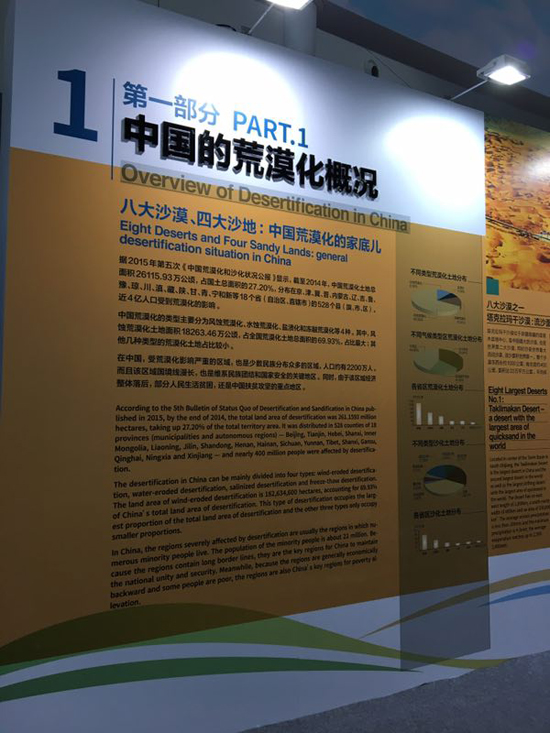Exhibition showcases China's fight against desertification
Updated: 2017-09-07  Print
Print 



An exhibition showcasing China's achievements in combating desertification opened on Wednesday in Ordos, North China's Inner Mongolia autonomous region, on the sidelines of the ongoing 13th Session of the Conference of the Parties (COP 13) to the United Nations Convention to Combat Desertification (UNCCD), which will last from Sept 6 to 17.

Chinese officials from the State Forestry Administration, the Foreign Ministry and the local government of the Inner Mongolia autonomous region as well as officials from the Secretariat of the UNCCD attended the launching ceremony.
Exhibition highlights
The exhibition highlights China's efforts to fight desertification over the 68 years since the founding of the People's Republic of China in 1949, as well as the results in slowing and even reversing desert expansion.

In addition to showing China's effective methods of blocking sand and restoring degraded land, the exhibition also recounts the stories of the desertification-combating pioneers who trekked deep into the hinterland of the barren desert areas.
The exhibition's separate sections on China's greening project on the edge of the vast sea of sand across North China, its undertaking to stop the sand's march, show the world what is meant by "Chinese Attitude", "Chinese Strategy", "Chinese Wisdom", "Chinese Sprit" and "Chinese Achievements".
The Chinese Strategy section highlights China's coordinated mechanism which required inter-regional and inter-organizational cooperation under the guidance of the government.
It also shows the importance of legal enforcement of regulations in controlling desertification and the supporting function of science and technology.
The section furthermore exhibits the enormous success of China's national forestation campaign, which includes projects like the Three-North Forest Shelterbelt Development Program, also known as the Green Great Wall, and that of the country’s efforts to control the factors causing sandstorms in Beijing and Tianjin.

Decades of effort
Challenged by the worsening situation of sparse vegetation resulting from accelerated desertification, the Chinese government, scientists and ordinary people had launched a large-scale campaign aimed at blocking sandstorms and desert expansion as early as the 1950s.
Beginning in 1978, the Chinese government introduced a tree-planting policy called the Three-North Forest Shelterbelt Development Program to limit the expansion of deserts by planting a series of windbreaks across northern regions of the country.
The national ecological engineering success in planting millions of trees along the thousands of kilometers bordering northern China's encroaching desert was truly remarkable.
China signed the UNCCD in October 1994 and ratified it in February 1997. To implement the convention, the Chinese government set up a nationwide system to monitor desertification and give early warning of its emerging trends.
In the early 2000s, China flexed its environmental muscles by enacting the Law of the People's Republic of China on Prevention and Control of Desertification. The legal system guaranteed fast tracking of the country's coordinated efforts to combat the problem.
Since 2012, China has further progressed ecologically under the leadership of the CPC Central Committee. A series of new national policies and large-scale efforts has been launched, including a new round of returning some farm and grazing lands to their more natural state of forests or grasslands, and a second-stage project to block sandstorms ravaging Beijing and Tianjin.

Achievements
Official data indicate that the decades of effort have contributed to the continuous shrinking of China's desertified and sandified areas and the lessening of vegetation destruction by wind erosion and sandstorms.
China has achieved the goal of "zero growth in global land deterioration" well before 2030, the goal set by the United Nations.





 Ordos Impression
Ordos Impression Ordos WeChat
Ordos WeChat Ordos Reported
Ordos Reported
